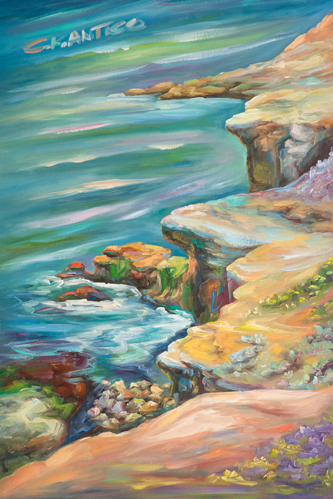One topic in this class that immediately intrigued me was tetrachromacy. I’ve always had the question of “What if what I view as blue, someone else views it as what I see as purple?”. A question like that may sound ridiculous to an adult who has had no background in the dynamics of vision and photoreceptors. It is easy to think that your own perspective of the world is the exact same experience of those around you, including humans and other animals. Although most humans only have three color receptors, there is potentially a very small percentage of us that have four. This means that instead of only seeing about 1 million different colors (combinations of red, green, and blue), like the average human, a person with four color receptors, a tetrachromat, would be able to see about 10 times more colors. If that doesn’t blow your mind, the mantis shrimp has between 12 and 16 color receptors! You can only imagine how many different combinations of colors this organism sees.
For one class, we had to read a paper on tetrachromacy: Art, interpersonal comparisons of color experience, and potential tetrachromacy. This particular article changed my perspective on color. Instead of viewing color as something that objects possess, this paper explains that it is actually a product of one’s own mind (Jameson et al. 2016). With this new view, it is easy to process the experiment in this paper. In this paper, researchers aim to compare the perception of a potentially tetrachromatic person with that of a trichromatic person. Although it is still unclear whether or not a tetrachromat would view daily life experiences differently from a trichromat, the results of this experiment indicate that there is a great amount of variation in perception between the two (Jameson et al. 2016)
Consistent with Jameson’s claim that color is an experience caused by the brain, a researcher of the molecular basis for color vision found that this experience is caused by the frequency of the Ser180Ala polymorphism in the red‐pigment gene (Deeb 2005). This causes two different spectrums of red cones, allowing for the potential of enhanced color vision.
This concept is actually very interesting when further investigated. An Australian artist, Concetta Antico, is believed to be a tetrachromat (Antico 2012). The diversity of color in her paintings serve as evidence for her capabilities. Although we may not see her paintings exactly the way she sees them, the wide range of unique color use is still visible. The processing of vision in the brain is fundamentally the same between trichromats and tetrachromats (Deeb 2005), therefore it may be possible that with proper focused training, a trichromat could enhance the variety of colors they see. Imagine being able to see the world in a way you never thought possible!

This is one of Antico’s many pieces of art. This is a personal favorite of mine because it truly redefines what summer is through use of many variations of color. Usually people perceive ocean water as a deep blue, however in this painting, Antico uses shades of a lighter blue, purple and even a green color. The way she combines these colors is truly spectacular.
Works Cited
Deeb, S. 2005. “The molecular basis of variation in human color vision.” Clinical Genetics, 67: 369-377. https://onlinelibrary.wiley.com/doi/full/10.1111/j.1399-0004.2004.00343.x
Kimberly A. Jameson, Alissa D. Winkler, Keith Goldfarb. 2016. “Art, interpersonal comparisons of color experience, and potential tetrachromacy.” Human Vision and Electronic Imaging, pp. 1-12. https://www.ingentaconnect.com/content/ist/ei/2016/00002016/00000016/art00050
Concetta Antico. 2012. “Concetta Antico ~ Tetrachromat & Fine Artist.” Zenava Inc. https://www.concettaantico.com/.
I completely agree with you, Antico’s painting is beautiful! It was a very good idea to use a painting as a visual example of how tetrachromats see differently then trichromats. And it is true it is very intriguing to know some humans are able to see more colors than us. I really appreciated that you took information from deferent research papers in order to explain the differences in color vision!
Since I was a kid, I always wondered if people see the same colors that I see. What if the color I see as red is someone else’s purple? It’s absolutely crazy to think about! I love the inclusion of Antico’s work as it really does a good job making the color look like a continuum. The colors just blend together and give the feeling of a lazy summer day.